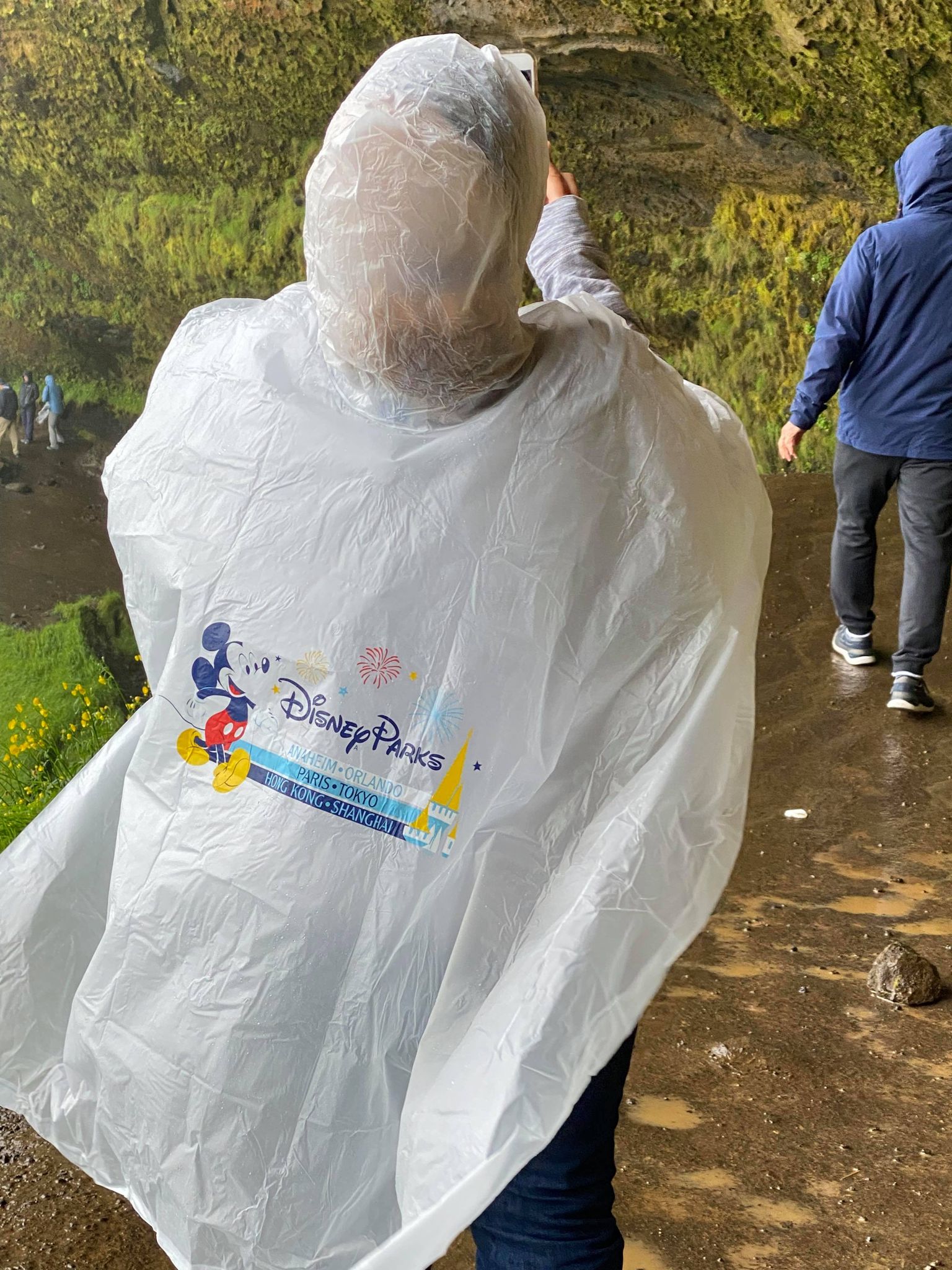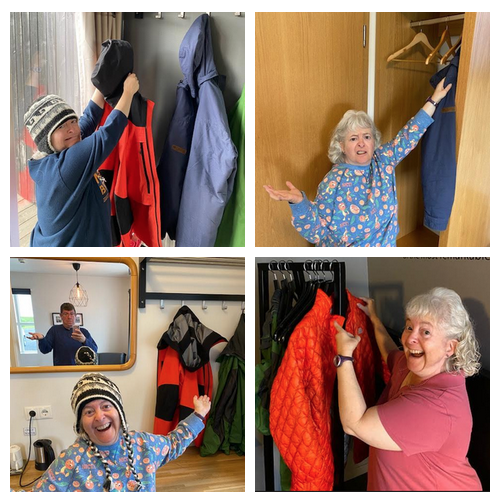When Joe and I went to Iceland, there were a few things we encountered that will probably never make it into the most well-researched guidebook.
I mean, everyone will tell you to make sure you don’t go over the speed limit when renting a car in Iceland, or what to do if you accidentally run over a sheep (spoiler: you’re supposed to tell the farmer. Thing is, no one tells you how to locate said farmer). But they’re all things that, I think, are important to know when planning a trip to Iceland.
The more water & windproof, the better
We were in Iceland for a week in July. So, summertime. The average temperature during summer in Iceland is about 50°F, but it can range from highs of 68-77°F, or lows of 43-48°F. We generally averaged about 50-55°F during our stay.
Regardless of the temperature, Iceland’s summertime weather is unpredictable – you can experience sun, clouds, rain and sun again, all within the course of an hour.
We personally experienced many clouds in Iceland, and a few days where it rained more often than not (happily, light or steady rain, not downpours). That’s to say nothing of all the times we were misted on by waterfalls and had to walk through mud puddles and small streams to get to see certain views. And did I mention the wind? Holy crap, THE WIND!
So…if you have a choice of a coat or jacket that’s water-resistant vs. water-repellent vs. waterproof, try to go for the “-proof.” From, (of all places) Home Depot:
- A water-resistant designation indicates a low level of protection against water. Clothing is coated with a substance that helps repel water, but it’s only lightly treated.
- Items designated as water-repellent are somewhat better than water-resistant, though the lack of an industry-wide standard of measure leaves the term open for debate. Water-repellent clothing is structurally designed and treated with hydrophobic coatings that repel with a thin-film nanotechnology. Some water repellent clothing is treated after the garment is made, while other companies treat the cloth before it is fashioned into garments.
- A waterproof designation indicates that the item is completely impervious to water. Waterproof clothing features a repellent coating that makes garments impervious to water.
Water-resistant clothing only works for a while and then you start to get wet anyway. The same goes for water repellent clothing, but for longer.
You should also seriously consider waterproof hiking boots and waterproof pants (the latter is good for the rain but also when going near waterfalls).
BTW, that poncho you got from Disney 3 years ago? That isn’t going to cut it. We saw this “behind the waterfall” at Seljalandsfoss Waterfall. It was windy and wet and, well, she looked pretty miserable.

Heads up that you might also want to consider windproof clothes. Wind resistant ones have nothing on the (literally) hurricane gusts you may encounter (although I discovered that my waterproof raincoat did a really good job against the wind, as well).
Everywhere has a hairdryer.
Iceland’s electricity system is European and unless you have a spare adapter and current converter, your hair dryer isn’t going to work. In fact, there’s a good chance you’ll fry your hair dryer without both on board. It’s OK though – even the smallest B&B includes a hairdryer.
Use toilets when you see them
When you go hiking 1.5km (just shy a mile) to see a waterfall, there’s no toilet at the top of the hill. However, there are public toilets at the base of many national park sites (some pay, some not). Happily, there are generally clean and not stinky. You know the old adage, “if you sprinkle when you tinkle, please be sweet and wipe the seat”? In Iceland, they usually do.
You may also have 2 hours between one attraction and the next, and if you’ve downed a Gull beer or two, you’re going to want to use a toilet. So use them when you see them – you may not know when you’ll hit another one.
About men’s vs. women’s vs. accessible toilets
And speaking of toilets…if a place is big enough to have multiple stalls (such as a larger restaurant), they’ll have dedicated men’s and women’s rooms, same as in the US. But if all they have are a handful of single rooms with toilets, they’re often marked with some form of Men/Women and are used by all, regardless of gender. One stall will be marked Men/Women/Wheelchair and that stall will usually have a raised toilet seat and grab bars.
Breakfast – most B&Bs won’t have anything hot
If you’re staying in a decent-sized hotel in Reykjavik that includes breakfast, chances are you’ll have a few hot options. Enjoy them because once you stay in small, privately owned B&Bs, breakfast will usually include various meats, fruits, vegetables, cheeses, breads (sometimes homemade, on-site!) and spreads, along with maybe hard-boiled eggs and some small cakes. But the only hot things you’ll encounter are tea and coffee.
Oh, and if you prefer artificial sweetener, bring plenty of your brand of choice – except for our hotel in Reykjavik, the Euro equivalents of Splenda, Equal and even Sweet & Lo were nowhere to be seen.
Going during the summer? It’s never dark out
We were in Iceland in July. Because the country is so far north, it never gets dark during that time of year. It’s kind of twilight for a few hours in the middle of the night, but that’s it. Most places had blackout curtains over the windows, but it didn’t stop the sun from shining through on the top, bottom and sides of the shade.
So if you like it to be “really” dark when you sleep, bring an eye mask.
Be prepared that hotels and B&Bs may feel too warm
We stayed in Iceland for 7 nights (3 in a hotel, and in 3 B&Bs, one of which we stayed at twice). We never had a thermostat in the room, and although the outside temps were in the low 50s, found that the room was usually much warmer than what we’re used to at home (we usually have it around 74 during the day and 71 at night. YMMV).
All 4 locations where we stayed had windows that could be opened – if yours do too, open them! And if you’re going in the summer and aren’t accustomed to temps in the 50s (hello, we live in Florida! We don’t see that kind of weather in July!), bring both winter and summer PJs so that way you’re prepared for anything.
If you usually use a washcloth, bring one
I usually use soft soap so for me, a washcloth is a must. However, I once stayed in a hotel in Japan that didn’t include washcloths. After that trip, I always carry a washcloth when I travel, in a zip-style bag.
I’m glad I had that washcloth in Iceland, because half of the B&Bs we stayed in didn’t offer washcloths.
So if you prefer to use a washcloth in the shower, bring your own, just in case.
Two nightstands! With plugs!
Joe has a handful of simple things he likes to have when he travels but one of the biggest is whether or not a hotel or B&B has a plug or even a nightstand on both sides of the bed.
Fortunately, everywhere we stayed in Iceland did 😉
Everyone speaks English
In the U.S. we tend to be pretty lazy when it comes to knowing a second language, much less a tertiary one or beyond. That’s not the case in Iceland and we found that virtually everyone we encountered spoke English. In fact, it was the “universal” language when the locals came across French, German, Polish, etc. visitors.
They don’t sell much bottled water
Iceland sells bottled water, but not nearly to the same extent as we do in the U.S. Honestly, they don’t have to – Icelandic tap water is delicious. Just bring a Camelbak or similar leakproof container and refill as needed.
Oh, and about their hot & cold running water
Y’all, their tap water is NO JOKE. Besides being delicious, their hot water is HOT and their cold water is COLD. Don’t scald or freeze yourself 😉
The places to hang your stuff in Iceland are TALL
Icelandic people are apparently TALL. If you’re really short, like under 5’, don’t expect to reach to use the hangers.
Granted, I’m super duper short – 4’6” – and could only reach the hangers in one place of the 4 we stayed at (fortunately, Joe is 6’ tall. It’s partially why I married him, y’know…someone had to be able to reach the top shelf!)

It’s OK to leave your stuff in car
If you do a DIY tour as we did, you’ll be driving with all your stuff every day (they drive on the same side of the road as us in Iceland, and have automatic transmissions available), seeing the sights until you get to the next place you’re going to sleep. It’s OK to leave your stuff in your car, as there’s apparently little crime in Iceland. Maybe don’t leave your wallet on the dashboard but your suitcases and backpacks should be safe.
Bring tissues!
If you’re going to visit Iceland in the winter (or even in the summer when the forecast is on the lower side), bring your own tissues. The B&Bs we encountered rarely provided them, and we found ourselves with runny noses when in the wind and chill. So either bring your own, or plan to use napkins or toilet paper for wiping and blowing your nose.
Plan your meals
Reykjavik has a decent amount of restaurants. However, once you leave town, there aren’t a whole lot of places to eat, as small towns are few and far between, and only may have 3 or 4 places to choose from, at best.
Many (but not all) B&Bs offer dinner. If where you’re staying serves dinner, plan accordingly (either tell them you’re going to eat there or have a set plan to eat somewhere else). And make sure you’re not too late for a meal or check-in!
Little-to-no place-specific merchandise
Along with our regular tree, Joe and I also put up what we call our “travel tree” at Christmastime. It’s a tree with ornaments of the places we’ve been. As we go places, we buy an ornament to add to the tree.
Anyway, heads up that Iceland has very little place-specific merchandise. Most waterfalls and other sites have small gift shops, but more often than not, it’s the same generic “Iceland” or “Northern Lights” merch over and over, rather than something specific to the region or attraction.
Feature photo: MaxPixel
Want to comment on this post? Great! Read this first to help ensure it gets approved.
Want to sponsor a post, write something for Your Mileage May Vary, or put ads on our site? Click here for more info.
Like this post? Please share it! We have plenty more just like it and would love it if you decided to hang around and sign up to get emailed notifications of when we post.
Whether you’ve read our articles before or this is the first time you’re stopping by, we’re really glad you’re here and hope you come back to visit again!
This post first appeared on Your Mileage May Vary

2 comments
As I’m sure you felt, 50 degrees in high winds (and maybe mist too) feels a whole lot colder than with sunshine and no wind! We always checked the wind chill factor to help out.
Also, if you go farther north, you may even need a bug net for your head, as Myvatn translates to “midge (tiny biting gnats) lake”!
We must have been lucky at Myvatn when we went…no bugs anywhere…usually the one bug within 100 miles finds me😁